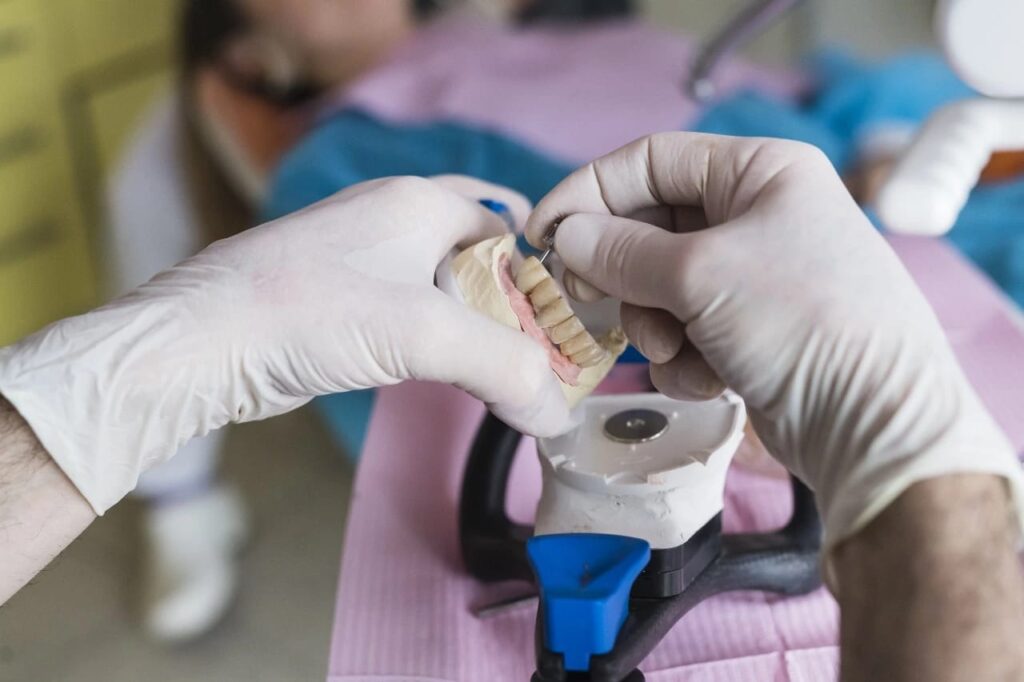Cavities are damaged areas in the teeth that develop into tiny holes. They are caused by a combination of factors, including bacteria, sugary foods, and poor oral hygiene.
Cavities, also known as tooth decay or dental caries, rank among the most common health problems worldwide. They affect people of all ages, though children and teenagers are particularly susceptible. The condition starts when plaque, the sticky film of bacteria that constantly forms on your teeth, interacts with the sugars and starches in your diet.
This interaction produces acids that can erode the tooth enamel, leading to cavities. Regular dental visits and good brushing and flossing habits are your first defense against cavities. Addressing cavities early is crucial because they can lead to more serious issues like toothaches, infections, and tooth loss. Therefore, understanding the causes and prevention of cavities is essential for maintaining overall dental health.

What Are Cavities?
Understanding what cavities are is essential for maintaining a healthy smile. These troublesome tooth issues can cause discomfort and lead to significant dental problems if left unchecked. This segment will shed light on the nature of cavities, demystifying them with a clear explanation and diving into their causes. Let’s sink our teeth into the world of dental caries and learn how to keep them at bay.
Definition Of Cavities
A cavity, medically referred to as dental caries, is a hole in the tooth that develops over time. Cavities form when the enamel, the hard outer layer of your tooth, begins to break down. This decay process is not instantaneous; it’s the result of a prolonged attack on the enamel by acids. When the enamel is compromised, the inner layers of the tooth can become exposed and damaged, leading to the need for professional dental intervention.
Causes Of Cavities
The genesis of cavities can often be traced back to a combination of factors that impact oral health. Primarily, they originate from plaque, a sticky film of bacteria that constantly forms on the teeth. When you consume foods and drinks high in sugars and starches, the bacteria in plaque produce acids. Without proper oral hygiene, these acids can erode the tooth enamel, creating cavities.
- High-sugar and starchy diet consuming food and beverages
- Poor oral hygiene failing to brush and floss regularly
- Lack of fluoride a deficiency that can weaken enamel
- Frequent snacking or sipping allows sugars to feed bacteria
- Dry mouth condition reduces saliva, a natural defense against cavities
These are just a few of the key players in cavity development, which, combined with individual factors like genetics and tooth morphology, define a person’s susceptibility to dental caries.
Symptoms And Signs
Detecting the early signs of cavities can prevent more severe dental problems and ultimately save your teeth. Knowing what to look for is essential to catch the sneaky onset of cavities. In this section, we explore the various symptoms that cavities may present as they develop. At first, these signs may be subtle, but as a cavity progresses, symptoms often become more pronounced and may even lead to significant discomfort or pain.
Early Signs Of Cavities
Initial stages of tooth decay are not always noticeable, but certain clues can signal the presence of a cavity. Being vigilant about these symptoms can aid in early intervention and treatment.
- Spotting Discoloration: Look for any white, brown, or black staining on the surface of your teeth.
- Mild Sensitivity: Feeling a slight twinge when consuming hot, cold, or sweet foods.
- Chalky Matte Appearance: A noticeable loss of the shiny, reflective enamel surface.
Progression Of Symptoms
As a cavity advances, the symptoms become more distinct and may intensify. Take note of the following progression of signs:
| Stage | Symptoms |
| Mild Progression |
|
| Advanced Decay |
|
Consistent oral hygiene practices are critical for preventing cavities. However, if you experience any of these symptoms, seek prompt dental advice to address the issue before it escalates. Regular dental check-ups can also assist in early detection and treatment of cavities.
Diagnosing Cavities
Uncovering the presence of cavities is a critical step to maintaining optimal dental health. Diagnosing cavities early can prevent complex common dental procedures and ensure tooth longevity. A comprehensive approach to detection merges both professional observations during a dental examination and insights gleaned from X-rays. Together, these diagnostic tools allow dentists to identify cavities accurately and prescribe the most effective treatments to keep your smile both healthy and bright.
Dental Examination
A dental examination is the first line of defense against tooth decay. During the examination, dentists use a variety of tools to check for soft spots or visual signs of decay. The process often includes:
- Visual Inspection: A thorough visual assessment can reveal plaque and tartar accumulation that could harbor bacteria, leading to cavities.
- Probing: Using a dental instrument known as an explorer, dentists can detect areas of enamel softening, a common indicator of cavity formation.
- Disclosing Solutions: These special dyes can expose the regions on teeth where plaque is prevalent, indicating potential trouble spots for cavity development.
These methods help narrow down the problematic sections that may require closer examination or immediate intervention.
X-rays
Dental X-rays are indispensable when it comes to spotting cavities not visible to the naked eye. They provide a detailed picture of:
| Location | Extent of Decay | Possible Treatments |
| Between Teeth | Early Stages to Advanced Decay | Fluoride Treatments to Fillings |
| Below the Gum Line | Emerging to Severe Cavities | Deep Cleanings to Root Canals |
X-rays help reveal not only the cavities’ existence but also their development stage. High-resolution images enable dentists to design a treatment plan that effectively targets and manages each specific case of decay.
Preventing Cavities
Cavities are more than just a minor inconvenience—they can lead to serious dental issues if left unchecked. But fear not, armed with the right knowledge and tools, you can create a robust defense against tooth decay. Prevention is key to maintaining a healthy smile, and below we delve into proven strategies that emphasize oral hygiene practices and dietary changes.
Oral Hygiene Practices
Maintaining impeccable oral hygiene is your first line of defense against cavity formation. It is essential to adopt a comprehensive routine that includes:
- Brushing twice a day: Use fluoride toothpaste and a soft-bristled toothbrush for two minutes, ensuring all surfaces of the teeth are cleaned thoroughly.
- Flossing daily: Floss reaches the nooks and crannies between teeth that a brush might miss, dislodging food particles and plaque.
- Rinsing with mouthwash: An antibacterial mouthwash can help kill bacteria and flush out debris that brushing and flossing may have loosened.
- Regular dental check-ups: Visiting your dentist every six months for a professional cleaning and examination can catch and address issues early.
In addition to these steps, consider the use of dental sealants, which provide a protective shield over the enamel of the back teeth.
Dietary Changes
What you eat plays a significant role in the health of your teeth. To bolster your cavity-fighting arsenal, consider these dietary adjustments:
| Consume | Limit |
|
|
Additionally, it’s vital to be mindful of snacking habits and to limit frequent sipping of sugary drinks to reduce the time teeth are exposed to acids that can lead to decay.
Treating Cavities
Discovering you have a cavity can be disappointing, but treatment options are readily available to restore your tooth’s integrity and relieve discomfort. Early intervention is key to prevent further decay and more complex procedures. Understanding the treatments available allows you to make an informed decision with your dentist. Here are the most commonly recommended treatments for cavities:
Filling Options
Dental fillings are the primary treatment for cavities at an early stage. The decayed material is removed, and a filling is placed to repair the tooth. Options for fillings include:
- Composite Resins: Aesthetically favored as they match the natural tooth color.
- Amalgam: A durable and cost-effective material, though less popular due to its visible silver appearance.
- Gold Fillings: Noted for their durability, but are a more expensive choice and require multiple visits.
- Ceramic: Made of porcelain, resistant to staining, and a popular middle-ground option.
- Glass Ionomer: Often used for children, as it can release fluoride to help protect the teeth.
Root Canal Therapy
When decay advances to affect the tooth’s pulp, root canal therapy is necessary. This procedure involves:
- Removing the infected or damaged pulp.
- Cleaning and disinfecting the inner chambers of the tooth.
- Filling and sealing the space to prevent further infection.
- Often followed by placing a crown to reinforce the tooth’s structure.
A successful root canal can save a tooth that might otherwise need extraction. It’s a common misconception that root canals are painful, but with modern techniques and anesthesia, discomfort is minimized.
Complications Of Untreated Cavities
Ignoring cavities can be a serious misstep in dental care. When unchecked, the decay that begins as a minor nuisance can escalate, causing a domino effect of dental health problems. The complications associated with untreated cavities extend far beyond simple toothaches. They pose a risk of severe infections, dental structure compromise, and long-term oral health issues.
Gum Disease
Cavities that remain untreated may pave the way for gum disease, a condition also known as periodontal disease. This ailment manifests when the health of the gums is compromised due to spreading bacteria. Common signs of gum disease include:
- Red or swollen gums
- Receding gum lines
- Persistent bad breath
- Tenderness or bleeding while brushing or flossing
Prompt treatment of cavities reduces the risk of gum disease significantly, helping to maintain healthy gums and strong teeth.
Abscess Formation
When cavities penetrate deep into the tooth and reach the pulp tissue, they can lead to the development of an abscess. An abscess is a pocket of pus caused by bacterial infection and is often characterized by:
- Severe, persistent tooth pain
- Swelling in the face or cheek
- Fever
- Sensitivity to the heat and cold
- Pain during chewing or biting
An abscess is a serious condition that can cause bone loss in the jaw and requires immediate medical attention. To prevent such infections, it is imperative to address cavities as they are discovered.
Children And Cavities
When it comes to dental health, cavities are one of the foremost concerns among parents. They are areas of permanent damage on the hard surface of teeth that develop into tiny holes or openings. Young children are particularly prone to cavities due to several factors, such as less refined brushing skills, a higher likelihood of consuming sugary snacks, and a lack of awareness about oral hygiene. Understanding why children are at risk and taking proactive steps for prevention is essential to maintain their oral health.
Special Considerations For Children’s Dental Health
Children’s teeth are more susceptible to decay for various reasons. Their enamel is not as hard as that of adults. They may also struggle with brushing effectively, missing spots that are prone to plaque buildup. Saliva, which plays a key role in fighting cavities, does not flow as much during sleep, leaving children’s teeth vulnerable overnight. Furthermore, many children take medications that can reduce saliva production or contain sugar to improve taste, contributing to the risk of cavities.
Prevention Methods For Children
To safeguard children against cavities, adopt comprehensive prevention strategies:
- Regular Brushing: Encourage brushing twice a day with fluoride toothpaste, and ensure that they brush for at least two minutes.
- Flossing: Start flossing between your child’s teeth as soon as two teeth touch each other.
- Limit Sugary Foods and Drinks: Reduce the frequency and quantity of sugary treats and encourage healthy snacks and water intake.
- Dental Checkups: Schedule regular dental checkups and cleanings to monitor and maintain dental health.
- Sealants: Consider asking your dentist about dental sealants that can protect teeth from decay.
Remember, early intervention is crucial. Teach children the importance of dental care from a young age to help establish healthy habits that can prevent cavities for a lifetime.
Frequently Asked Questions On Cavities
Can Cavities Go Away?
Cavities cannot heal completely on their own once tooth enamel is eroded. Early-stage tooth decay may be reversible with proper oral hygiene and fluoride treatments. Regular dental check-ups are essential for preventing cavities from worsening.
Can Tooth Cavity Be Treated?
Yes, tooth cavities can be treated. Early-stage cavities often require a filling, while advanced decay may need a crown or a root canal. Regular dental check-ups help detect and treat cavities effectively.
What Happens When Cavities Go Untreated?
Untreated cavities can lead to tooth decay and infection. This may result in severe toothache, abscess formation, and potential tooth loss. Early dental intervention prevents complications.
How Do You Relieve A Cavity?
To relieve a cavity, visit a dentist for professional treatment. At home, practice good oral hygiene, use fluoride toothpaste, avoid sugary foods, and rinse with salt water for temporary relief.
Conclusion
Maintaining oral health is crucial for avoiding cavities. Regular check-ups, proper brushing, and a balanced diet are key. Remember, early intervention can save your smile. Committing to dental care is an investment in your overall well-being. Say goodbye to cavities, and hello to a healthy, radiant smile.







